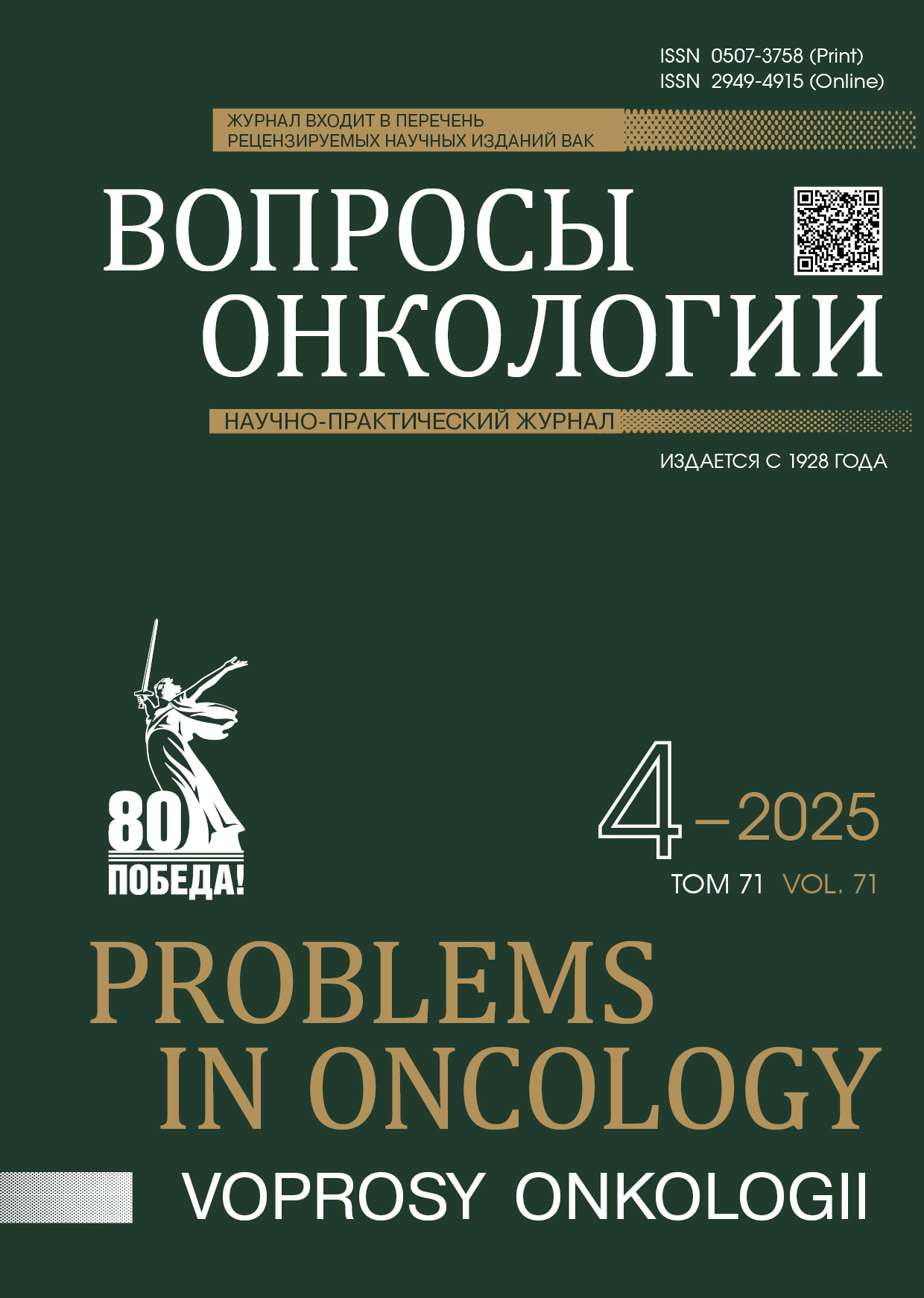Аннотация
Введение. Своевременная диагностика онкологических заболеваний повышает выживаемость пациентов и снижает затраты на здравоохранение за счет сокращения числа госпитализаций и повышения шансов на ремиссию. Сохраняется необходимость в практичных и интерпретируемых инструментах скрининга, которые могут эффективно способствовать раннему выявлению пациентов с онкологическими заболеваниями, для своевременного вмешательства.
Цель. Разработка и внешняя валидация моделей машинного обучения для прогнозирования вероятности развития онкологических заболеваний в течение 18 мес. на основе данных реальной клинической практики.
Материалы и методы. В исследовании использовались анонимизированные данные электронных медицинских карт 1,3 млн пациентов 36 регионов Российской Федерации. В качестве предикторов рассмотрены пол, возраст, среднее изменение массы тела за месяц, скорость оседания эритроцитов, гемоглобин крови, индекс массы тела и история клинически значимых сопутствующих заболеваний. Целевое событие представлено любым онкологическим заболеванием, определенным по кодам группы С МКБ-10 у 177 384 пациентов. Для сравнения использовались модели Logistic Regression, LGBMClassifier, Random Forest, Linear Discriminant Analysis и Naive Bayes. Внешняя валидация проводилась на данных из регионов с различным географическим происхождением (29 681 и 25 145 пациентов).
Результаты. Модель на основе LGBMClassifier продемонстрировала лучшие результаты с AUROC 0,807 (95 % ДИ 0,798–0,815) при внутреннем тестировании, а также на внешних данных, взятых из отдельного региона и отдельного временного промежутка (0,794 (95 % ДИ 0,786–0,800) и 0,790 (95 % ДИ 0,782–0,798) соответственно).
Заключение. Новый подход с использованием модели машинного обучения, подготовленной на простых и распространенных клинических, лабораторных и анамнестических признаках, продемонстрировал эффективность и практичность применения как на внешних данных, так и по сравнению с предыдущими исследованиями.
Библиографические ссылки
Usher-Smith J., Emery J., Hamilton W., et al. Risk prediction tools for cancer in primary care. British Journal of Cancer. 2015; 113(12): 1645–50.-DOI: 10.1038/bjc.2015.409.
Chiang P.C., Glance D., Walker J., et al. Implementing a qcancer risk tool into general practice consultations: An exploratory study using simulated consultations with Australian general practitioners. Br J Cancer. 2015; 112(S1): S77–83.-DOI: 10.1038/bjc.2015.46.
Hippisley-Cox J., Coupland C. Development and validation of risk prediction algorithms to estimate future risk of common cancers in men and women: Prospective cohort study. BMJ Open. 2015; 5(3): e007825.-DOI: 10.1136/bmjopen-2015-007825.
Kulm S., Kofman L., Mezey J., Elemento O. Simple linear cancer risk prediction models with novel features outperform complex approaches. JCO Clin Cancer Inform. 2022; (6).-DOI: 10.1200/CCI.21.00166.
Miotto R., Li L., Kidd B.A., Dudley J.T. Deep patient: an unsupervised representation to predict the future of patients from the electronic health records. Sci Rep. 2016; (6).-DOI: 10.1038/srep26094.
Watson J., Salisbury C., Banks J., et al. Predictive value of inflammatory markers for cancer diagnosis in primary care: a prospective cohort study using electronic health records. Br J Cancer. 2019; 120(11): 1045–51.-DOI: 10.1038/s41416-019-0458-x.
Nicholson B.D., Hamilton W., Sullivan J.O’, et al. Weight loss as a predictor of cancer in primary care: A systematic review and meta-analysis. 2018; 68(670): e311–22, Royal College of General Practitioners.-DOI: 10.3399/bjgp18X695801.
Hung N., et al. Risk of cancer in patients with iron deficiency anemia: A nationwide population-based study. PLoS One. 2015; 10(3): e0119647.-DOI: 10.1371/journal.pone.0119647.
Star J., et al. Updated review of major cancer risk factors and screening test use in the United States, with a focus on changes during the COVID-19 pandemic. 2023; 32(7): 879–88. American Association for Cancer Research Inc.-DOI: 10.1158/1055-9965.EPI-23-0114.
Collins G.S., Reitsma J.B., Altman D.G., Moons K.G.M. Transparent reporting of a multivariable prediction model for individual prognosis or diagnosis (TRIPOD): The TRIPOD Statement. BMC Med. 2015; 13(1): 1.-DOI: 10.1186/s12916-014-0241-z.
Collins G.S., Moons K.G.M., Dhiman P., et al. TRIPOD+AI statement: updated guidance for reporting clinical prediction models that use regression or machine learning methods. BMJ. 2024; e078378.-DOI: 10.1136/bmj-2023-078378.
Kapoor S., Narayanan A. Leakage and the reproducibility crisis in machine-learning-based science. Patterns. 2023; 4(9): 100804.-DOI: 10.1016/j.patter.2023.100804.
Li C. Little′s test of missing completely at random. The Stata Journal. 2013; 13(4): 795–809.-DOI: 10.1177/1536867X1301300407.
Sokolova M., Lapalme G. A systematic analysis of performance measures for classification tasks. Inf Process Manag. 2009; 45(4): 427–37.-DOI: 10.1016/j.ipm.2009.03.002.
Zoubir A., Iskandler D. Bootstrap methods and applications. IEEE Signal Processing Magazine. 2007; 24(4): 10–9.-DOI: 10.1109/msp.2007.4286560.
Fischer G., Evans A.T. SpPin and SnNout are not enough. It’s Time to fully embrace likelihood ratios and probabilistic reasoning to achieve diagnostic excellence. J Gen Intern Med. 2023; 38(9): 2202–4.-DOI: 10.1007/s11606-023-08177-5.
Lundberg S.M., Erion G., Chen H., et al. From local explanations to global understanding with explainable AI for trees. Nat Mach Intell. 2020; 2(1): 56–67.-DOI: 10.1038/s42256-019-0138-9.
Van Calster B., McLernon D.J., van Smeden M., et al. Calibration: the Achilles heel of predictive analytics. BMC Med. 2019; 17(1).-DOI: 10.1186/s12916-019-1466-7.
Ding Y., Simonoff J. An investigation of missing data methods for classification trees applied to binary response data. J Mach Learn Res. 2010; 11: 131-70.-DOI: 10.5555/1756006.1756012.
Cao X.H., Stojkovic I., Obradovic Z. A robust data scaling algorithm to improve classification accuracies in biomedical data. BMC Bioinformatics. 2016; 17(1): 359.-DOI: 10.1186/s12859-016-1236-x.
de Amorim L.B.V., Cavalcanti G.D.C., Cruz R.M.O. The choice of scaling technique matters for classification performance. Appl Soft Comput. 2023; 133: 109924.-DOI: 10.1016/j.asoc.2022.109924.
Weiss G.M. Foundations of imbalanced learning. In: He H., Ma Y., eds. Imbalanced learning: foundations, algorithms, and applications. Hoboken (NJ): John Wiley & Sons. 2013; 13-41.-ISBN: 9781118074626.
Ke G., Meng Q., Finley T., et al. LightGBM: a highly efficient gradient boosting decision tree. Adv Neural Inf Process Syst. 2017.
Breiman L. Random forests. Mach Learn. 2001; 45(1): 5-32.-DOI: 10.1023/A:1010933404324.
Akiba T., Sano S., Yanase T., et al. Optuna: a next-generation hyperparameter optimization framework. In: Proceedings of the 25th ACM SIGKDD International Conference on Knowledge Discovery & Data Mining; 2019; 2623-31.-DOI: 10.1145/3292500.3330701.
Wester D.B. Comparing treatment means: overlapping standard errors, overlapping confidence intervals, and tests of hypothesis. Biom Biostat Int J. 2018; 7(1): 73-85.-DOI: 10.15406/bbij.2018.07.00192.

Это произведение доступно по лицензии Creative Commons «Attribution-NonCommercial-NoDerivatives» («Атрибуция — Некоммерческое использование — Без производных произведений») 4.0 Всемирная.
© АННМО «Вопросы онкологии», Copyright (c) 2025

